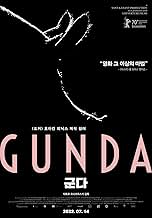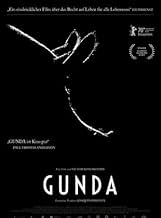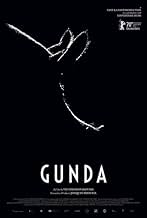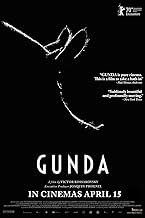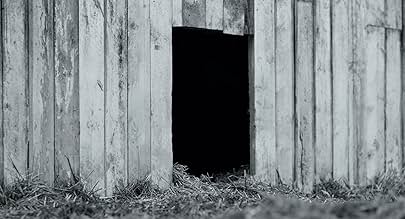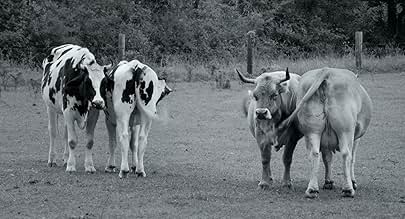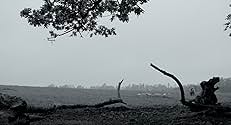VALUTAZIONE IMDb
7,1/10
3133
LA TUA VALUTAZIONE
Il documentario racconta la vita quotidiana di un maiale e dei suoi compagni animali da fattoria: due mucche e una gallina con solo una gamba.Il documentario racconta la vita quotidiana di un maiale e dei suoi compagni animali da fattoria: due mucche e una gallina con solo una gamba.Il documentario racconta la vita quotidiana di un maiale e dei suoi compagni animali da fattoria: due mucche e una gallina con solo una gamba.
- Regia
- Sceneggiatura
- Star
- Premi
- 9 vittorie e 32 candidature totali
Recensioni in evidenza
Greetings again from the darkness. We open on a pig in prone position with her head sticking through an opening in the barn. It takes a minute to realize the sow isn't sleeping, but rather giving birth. Slowly the newborn piglets begin tumbling out into the world. Cutting to a reverse camera angle, we see the 12-13 babies desperately trying to latch onto mom for their first meal. The runt of the litter struggles more than the others. Award-winning filmmaker Viktor Kosakovskiy runs this first segment just over 19 minutes. There is no dialogue. No human on screen. The soundtrack is all natural from nature: the snorts from mama sow, the squeals from piglets, and unseen birds chirping.
Our second segment finds roosters in a crate. Clearly new to the surroundings, and likely never-before "free" to roam the land, these chickens cautiously explore as the camera focuses on their tentative initial steps from the cage and startled reactions to birds. A one-legged rooster captures our attention as it makes its way through the grass and over fallen logs. It's likely the longest amount of time a movie camera has been dedicated to following roosters around.
We then head back to find the piglets have grown substantially. We don't know how much time has passed, but we watch along with their mother as the youngsters play in the field, fight with each other, and bully their youngest sibling. Gunda, the mother sow, watches over them just as any mother would watch over her kids. Our third group is introduced as the barn door opens and the cows are released. They romp into the fields like school kids at recess. Some of the cows stare directly into the camera as if to inform us they are ready for their close-up. It's fascinating to see how they use teamwork for an ingenious head-to-tail solution to the annoying flies that relentlessly pester them.
The final segment returns us to the pigs as they display the same feeding frenzy as one might witness at the buffet on a Carnival cruise. An ending that will surely evoke emotions in viewers, though maybe not at the extreme of Gunda herself. Filmmaker Kosakovskiy leaves us wondering how a black and white film with no dialogue or human characters makes such an impression as it focuses on farm animals. Pork, chicken, and beef. Clearly it's no coincidence that he chose three staples of the American diet. There is no lecture on animal rights, and none of the brutality of other "raised for food" documentaries is shown. But the message is there. It was filmed on farms in Norway, Spain, and the U. K., but the locales matter little. Director Kosakovskiy previously brought us the excellent AQUARELA (2018), a documentary showcasing the nature of water and ice, and here he assisted Egil Haskjold Larsen with cinematography, and Ainara Vera with editing. It's an unusual film, and one meant to inspire reflection and thought ... and hopefully change.
In theaters beginning April 16, 2021.
Our second segment finds roosters in a crate. Clearly new to the surroundings, and likely never-before "free" to roam the land, these chickens cautiously explore as the camera focuses on their tentative initial steps from the cage and startled reactions to birds. A one-legged rooster captures our attention as it makes its way through the grass and over fallen logs. It's likely the longest amount of time a movie camera has been dedicated to following roosters around.
We then head back to find the piglets have grown substantially. We don't know how much time has passed, but we watch along with their mother as the youngsters play in the field, fight with each other, and bully their youngest sibling. Gunda, the mother sow, watches over them just as any mother would watch over her kids. Our third group is introduced as the barn door opens and the cows are released. They romp into the fields like school kids at recess. Some of the cows stare directly into the camera as if to inform us they are ready for their close-up. It's fascinating to see how they use teamwork for an ingenious head-to-tail solution to the annoying flies that relentlessly pester them.
The final segment returns us to the pigs as they display the same feeding frenzy as one might witness at the buffet on a Carnival cruise. An ending that will surely evoke emotions in viewers, though maybe not at the extreme of Gunda herself. Filmmaker Kosakovskiy leaves us wondering how a black and white film with no dialogue or human characters makes such an impression as it focuses on farm animals. Pork, chicken, and beef. Clearly it's no coincidence that he chose three staples of the American diet. There is no lecture on animal rights, and none of the brutality of other "raised for food" documentaries is shown. But the message is there. It was filmed on farms in Norway, Spain, and the U. K., but the locales matter little. Director Kosakovskiy previously brought us the excellent AQUARELA (2018), a documentary showcasing the nature of water and ice, and here he assisted Egil Haskjold Larsen with cinematography, and Ainara Vera with editing. It's an unusual film, and one meant to inspire reflection and thought ... and hopefully change.
In theaters beginning April 16, 2021.
IN BRIEF: A well-made but slow moving pig's tale.
JIM'S REVIEW: (RECOMMENDED) A pig and her litter, a one-legged chicken, and some cows are the main cast in this fine documentary, Gunda, Viktor Kosakovskiy's understated cinematic plea for animal rights.
Gunda is an enormous sow that has just given birth to a dozen small piglets. This is their story of life down on the farm. Call me a city boy, but the film depicts the daily mundane weeks in this pig's heaven (or hell) and I have chosen the right lifestyle for me. Still, it is a fascinating place to visit.
There are no voiceovers, no sweeping musical score, no Disney sentimentalizing... just straight-forward filming of natural country events. There are many grunts, squeals, and moos to be heard and lots of mud and flies buzzing around too.
This is a well-made documentary that tries to convey an animal's everyday existence. The wonderful sound design by Alexander Dudarev immerses the moviegoer into this rarely-seen animal kingdom. The masterful b&w photography by Egil Håskjold Larsen and the director is stunning with its low-level point of view and detailed close-ups of farm critters.
However, the story seems non-existent and Mr. Kosakovskiy lets scenes go on for far too long, at a turtle's pace, although none of those creatures are in sight. The documentary does eventually build to its subtle message about the cruelty of our food chain, but any astute moviegoer knows the fate of our little dirty dozen from the start. (A side note: All of our violent deeds are strongly implied, but mercifully not shown.) I could say there is much food for thought in this documentary, but then I would be called insensitive or callous. Let's just say, this film deserves your attention. (GRADE: B-)
JIM'S REVIEW: (RECOMMENDED) A pig and her litter, a one-legged chicken, and some cows are the main cast in this fine documentary, Gunda, Viktor Kosakovskiy's understated cinematic plea for animal rights.
Gunda is an enormous sow that has just given birth to a dozen small piglets. This is their story of life down on the farm. Call me a city boy, but the film depicts the daily mundane weeks in this pig's heaven (or hell) and I have chosen the right lifestyle for me. Still, it is a fascinating place to visit.
There are no voiceovers, no sweeping musical score, no Disney sentimentalizing... just straight-forward filming of natural country events. There are many grunts, squeals, and moos to be heard and lots of mud and flies buzzing around too.
This is a well-made documentary that tries to convey an animal's everyday existence. The wonderful sound design by Alexander Dudarev immerses the moviegoer into this rarely-seen animal kingdom. The masterful b&w photography by Egil Håskjold Larsen and the director is stunning with its low-level point of view and detailed close-ups of farm critters.
However, the story seems non-existent and Mr. Kosakovskiy lets scenes go on for far too long, at a turtle's pace, although none of those creatures are in sight. The documentary does eventually build to its subtle message about the cruelty of our food chain, but any astute moviegoer knows the fate of our little dirty dozen from the start. (A side note: All of our violent deeds are strongly implied, but mercifully not shown.) I could say there is much food for thought in this documentary, but then I would be called insensitive or callous. Let's just say, this film deserves your attention. (GRADE: B-)
This is a superb piece of filmmaking that gives the viewer a real insight in to the lives of pigs and cows on higher welfare farms and of free to roam hens. No one who watches this film could doubt the sentience of its subjects or their individuality. The incredibly devoted mother pig at the centre of this film and a one legged hen are exhibits A and B in this regard. Sound is used to particularly good effect, both in the capture of the farm and country noises and in the complete absence of any commentary. The black and white footage adds to the beauty of the piece but I can't help thinking that the complete absence of colour ultimately detracts a little from an otherwise wholly authentic film. The film may not turn you into a vegetarian or a vegan but for me it surely supports an argument that particularly in the rich developed world all animals should be raised to at least "freedom food" standards and that its an indictment of modern society that some of the richest countries have the poorest animal welfare standards.
A small film, a moving and beautiful film, a film that moves at the pace of farm animals.
It is set in another universe that is open to us but that we don't visit.
It is set in another universe that is open to us but that we don't visit.
...although more of the story of the chickens and cows life would have balanced it better.
Many informative reviews here already, hence I wanted to add some facts I looked up afterwards, also as some here got it wrong, but I won't as I don't like spoilers. You find every question which (hopefully) pops up afterwards by doing a quick search.
I'll only leave a good note I liked from AccidentalSmallHolder net ehich addresses something you'll (hopefully) also think about afterwards:
"If pig keeping isn't for you, please do the next best thing and source your pork, bacon and sausages from ethically reared pigs. If it doesn't say the pigs are born and reared outdoors, they probably weren't so don't be fooled by misleading labelling. Even pigs that are reared outdoors may have been born to sows kept indoors, in crates, so do be aware of labelling - it's more about what it doesn't say, than what it does."
Many informative reviews here already, hence I wanted to add some facts I looked up afterwards, also as some here got it wrong, but I won't as I don't like spoilers. You find every question which (hopefully) pops up afterwards by doing a quick search.
I'll only leave a good note I liked from AccidentalSmallHolder net ehich addresses something you'll (hopefully) also think about afterwards:
"If pig keeping isn't for you, please do the next best thing and source your pork, bacon and sausages from ethically reared pigs. If it doesn't say the pigs are born and reared outdoors, they probably weren't so don't be fooled by misleading labelling. Even pigs that are reared outdoors may have been born to sows kept indoors, in crates, so do be aware of labelling - it's more about what it doesn't say, than what it does."
Lo sapevi?
- QuizJoaquin Phoenix and Paul Thomas Anderson were amongst the first people in the industry to publicly praise the film.
- BlooperGunda is shown wallowing in mud and the mud covers her teats. In the next sequence, her piglets suckle her teats which are suddenly clean.
I più visti
Accedi per valutare e creare un elenco di titoli salvati per ottenere consigli personalizzati
Dettagli
- Data di uscita
- Paesi di origine
- Siti ufficiali
- Lingua
- Celebre anche come
- Gunda: Mother, Pig
- Luoghi delle riprese
- Grøstad farm, Undrumsdal in Tønsberg municipality, Norvegia(the pig farm location)
- Aziende produttrici
- Vedi altri crediti dell’azienda su IMDbPro
Botteghino
- Lordo Stati Uniti e Canada
- 115.691 USD
- Fine settimana di apertura Stati Uniti e Canada
- 5023 USD
- 18 apr 2021
- Lordo in tutto il mondo
- 383.128 USD
- Tempo di esecuzione1 ora 33 minuti
- Colore
- Proporzioni
- 1.85 : 1
Contribuisci a questa pagina
Suggerisci una modifica o aggiungi i contenuti mancanti




